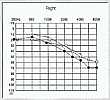This page presents movies and sounds of Antique Computers
Organized into
- Musical Sounds
- Other Sounds
- How electrical noise gets to our ears
- Video Clips
- for docent training in an older home for Computer History Museum - about year 2002 - - Movies of various restoration efforts
Musical Sounds from stored program computers
Ferranti Mark 1
The UNIVAC I at Case played music. The system as designed I believe
had a speaker on one of the serial memory busses. This was
convenient for operators to hear a stop, stall or hang. I believe
the music program wasn't written at Case. Digibarn's site claims
that UNIVAC freely distributed a music playing program and they have
the program on their want list.
One of the songs was "Bicycle Built for Two" and was usually the
most popular for demos.
Now leap forward to Kubrick's 2001
film. As HAL was being decommissioned by unplugging its memories,
you might remember that one of the last things it did was play the
refrain from Daisy Bell ("Bicycle Built for Two"). Maybe this is a
coincidence, but I always liked to believe it was a reference to the
earliest computer playback of music. Wikipedia credits a visit by
Kubrick to Bell Labs and an IBM 704 speech demonstration of Daisy
Bell as the HAL going to sleep inspiration,
see http://en.wikipedia.org/wiki/Daisy_Bell. Apparently this was
circa 1962 and long after the UNIVAC I was playing music.
Since the U-I has good claim on "first commercial computer" the
first is likely "playback of music on a commercial computer", since
all "firsts" need many qualifiers. The CBI transcript of the
Unisys-CBI-Smithsonian 1990 UNIVAC conference has a claim by Francis
Holberton that he, not Mauchly wrote a music program for the
dedication party (likely early 1951) of the first working UNIVAC I (see
http://www.cbi.umn.edu/oh/pdf.phtml?id=49 pages 72/73). Also, it is
claimed that a tape of the program was given to CBI.
I suspect that Al's [Kossow] "universal" 1/2" magnetic tape reader could be
set up to read UNIVAC I tapes as they were readable on later
generations of UNISERVOS (the Case 1107 UNISERVO IIA's could read
them). This would be a very interesting software recovery project!
Grant
LaFarr Stuart says he programmed the
CYCLONE computer at Iowa State
to "make music", and "I think I was the first to play computer music on a radio network, NBC, back in 1961."
A table of contents for "Musical Sounds" - little attempt at chronological sequence of anything
- Disclaimer - In the mid-1970s, I [Ed Thelen] spent many hours on our first family computer, a Commodore PET,
trying out recipes for making melodies. (I think there was an article in Scientific American about others having done it.)
from Cass Devlin via LaFarr Stuart, June 2008
The first computer recorded playing "music" might be from a 1951 Ferranti Mark 1 - which the BBC says was a commercial version of the
(Manchester) "Baby", see/listen-to this link
-
and
from Grant Saviers
In case you haven't seen it, here is more evidence for awarding the
"first computer music" medal to Univac from David Grier's column in
last December's [2006] Computer magazine. I'm quite confused about models
and dates, though, because he talks about "December 1958" and the
staff in Univac's North Dallas office using a Univac 1103. But the
Univac I was delivered in 1951, and the 1103 in 1953. I don't think
Univac existed as a company until 1950. I've copied David in case he
wants to comment.
-- Len
At 08:47 PM 1/25/2007, Grant Saviers wrote:
I suspect the UNIVAC I wins the "first" medal for playing music
generated from a computer bus. I haven't heard others tell this
story, so I thought I would add it to the folklore.
The following items are courtesy of
"Haus zur Geschichte der IBM Datenverarbeitung" (HzG)
"House of the History of IBM Data Processing"
located in Sindelfingen, Germany
|
How electrical noise gets to our ears
|
The "music" can be coupled
- from an electronic device - to the amplifier/speaker (for our ears) by at least two methods:
An early example of computer "music" (note that I stayed safe and didn't say "first" ;-))
is
It is good to remember that
Given the high frequencies of the fundamentals
Many "noise" sources have their fundamental frequency well above human hearing
|
| Computer History Archives Project, Vintage Educational Films, Early Computers |
On Wimp
|
The following items are courtesy of
"Haus zur Geschichte der IBM Datenverarbeitung" (HzG)
"House of the History of IBM Data Processing"
located in Sindelfingen, Germany
|
On YouTube
|
| I've posted some older Computer History Museum docent training videos from when the museum was located at Moffett Field before moving into the current building in Mountain View.
On YouTube
|
Movies of various restoration efforts
If you have comments or suggestions, Send e-mail
to Ed Thelen
Go to Antique Computer home page
Started April 10, 2006
Updated May 17, 2016
Return to top
